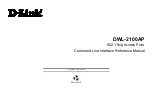
4-41
Radio Interface
Delivery Traffic Indication Message (DTIM)
– The rate at which stations in sleep
mode must wake up to receive broadcast/multicast transmissions.
The DTIM interval indicates how often the MAC layer forwards
broadcast/multicast traffic, which is necessary to wake up stations that are using
Power Save mode. The default value of 1 indicates that the access point will save
all broadcast/multicast frames for the Basic Service Set (BSS) and forward them
after every beacon. Using smaller DTIM intervals delivers broadcast/multicast
frames in a more timely manner, causing stations in Power Save mode to wake up
more often and drain power faster. Using higher DTIM values reduces the power
used by stations in Power Save mode, but delays the transmission of
broadcast/multicast frames.
(Range: 1-255 beacons; Default: 1 beacon)
Fragment Length (256~2346)
– Configures the minimum packet size that can be
fragmented when passing through the access point. Fragmentation of the PDUs
(Package Data Unit) can increase the reliability of transmissions because it
increases the probability of a successful transmission due to smaller frame size. If
there is significant interference present, or collisions due to high network
utilization, try setting the fragment size to send smaller fragments. This will speed
up the retransmission of smaller frames. However, it is more efficient to set the
fragment size larger if very little or no interference is present because it requires
overhead to send multiple frames. (Range: 256-2346 bytes; Default: 2346 bytes)
RTS Threshold
– Sets the packet size threshold at which a Request to Send (RTS)
signal must be sent to a receiving station prior to the sending station starting
communications. The access point sends RTS frames to a receiving station to
negotiate the sending of a data frame. After receiving an RTS frame, the station
sends a CTS (clear to send) frame to notify the sending station that it can start
sending data.
If the RTS threshold is set to 0, the access point always sends RTS signals. If set to
2347, the access point never sends RTS signals. If set to any other value, and the
packet size equals or exceeds the RTS threshold, the RTS/CTS (Request to Send /
Clear to Send) mechanism will be enabled.
The access points contending for the medium may not be aware of each other.
The RTS/CTS mechanism can solve this “Hidden Node Problem.” (Range: 0-2347
bytes: Default: 2347 bytes)
Содержание 3CRWE876075 / WL-546
Страница 6: ...6...
Страница 14: ...1 6 CHAPTER 1 INTRODUCTION...
Страница 40: ...3 12 CHAPTER 3 INITIAL CONFIGURATION...
Страница 68: ...4 28 CHAPTER 4 SYSTEM CONFIGURATION Figure 32 WDS and Spanning Tree Settings...
Страница 254: ...5 152 CHAPTER 5 COMMAND LINE INTERFACE...
Страница 258: ...6 4 CHAPTER 6 TROUBLESHOOTING...
















































